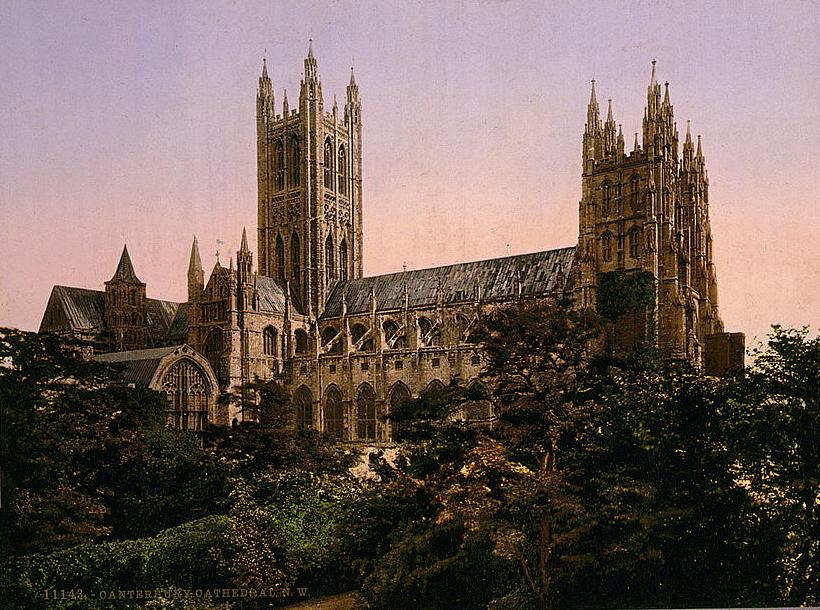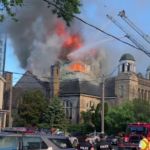Culture, Historical Essays
“Rave in the Nave”: On the Desecration of English Churches
“The great cathedrals, so full of beauty and interest, are now like whales washed up on an alien shore, the faith that built them a flickering light,” James Patrick once wrote. He was right. Everyone accepts that the great churches of Europe are still very important, somehow—remember the public outpouring of grief when Notre Dame was burning?—but most can no longer articulate why. The recent “rave in the nave,” in which a booze-fueled disco was held in Canterbury Cathedral, one of England’s oldest and most storied churches, caused outrage from believers and nonbelievers alike. The event—which was defended by the presiding rector, a gay man married to his partner—just seemed unseemly, somehow. We’re not sure what these spaces are for anymore—but not for that.
But why not? If the ancient cathedral—whose origins date back to 597, when Augustine of Canterbury was sent by Pope Gregory the Great to evangelize the English—is simply a grand old building, then what is the problem with disco lights raking the ancient columns and a makeshift bar in the nave as young people dance the night away a stone’s throw from where St. Thomas Becket was martyred in the 12th century? If nothing is sacred, nothing can be desecrated. If nothing is sacred, there is no sacrilege. If nothing is truly sacred, then hosting a disco atop the grave of St. Dunstan makes sense. As Ben Sixsmith noted recently in The Critic, Britain cannot be a ‘culturally Christian’ country without Christians.
It isn’t just Canterbury, either. A rave was held in the 1,000-year-old Winchester Cathedral, in Guildford Cathedral, and in Hereford Cathedral, which was built atop the tomb of St. Ethelbert the King. These parties are being held in churches across the UK to raise money for their upkeep now that tithes have dried up, and so the churches that once hosted choirs singing sacred songs now feature music that, according to one attendee, is “from recent decades—in this case the 1990s, and so songs from artists such as Eminem, Britney Spears, Elton John and the Spice Girls.” Lose yourself, indeed.
Even where the ancient songs are still the primary fare, things have changed. I was asked to give a talk to a group of Christian students in the Round Church in Cambridge recently, and my wife and I took the opportunity to attend Evensong at Cambridge’s King’s College Chapel. The world-famous choir comprises 16 boy choristers between ages 9 and 13 and 14 male undergraduates. The service was gorgeous—the sonorous readings from the King James Bible, the choir in the cavernous church, Thomas Cranmer’s Book of Common Prayer. Then, right in the middle of the liturgy, the choir launched into a frenzied, jarring modern song called “Identity,” about a body found in the river. It was clearly supposed to be about the forgotten members of society, or something. It was the liturgical equivalent of graffiti on stained-glass windows.
Exploring England’s religious heritage is rewarding despite all that. Cambridge’s religious history runs deep—one church actually has Anglo-Saxon foundations. It is also the site of the White Horse Inn, known as “Little Germany” and “the birthplace of the Reformation in England,” where scholars debated the freshly published works of Martin Luther. A short walk away is The Pickerel Inn, where Lewis and Tolkien regularly met for a pint. The Round Church itself was built around 1130 and features a wonderful exhibit titled “The Impact of Christianity in England.” The great abolitionist William Wilberforce attended services there at least once, and it was thrilling to speak amongst the same towering stone pillars that once hosted the greatest man in Great Britain.
We also visited the Chapel of St. John the Evangelist in the White Tower at the Tower of London. It is a stunning example of Anglo-Norman ecclesiastical architecture, built in 1080 for William the Conqueror. Chairs face several large stained-glass windows at the front of the tunnel-vaulted nave of white Caen stone, with the arches held aloft by thick, round pillars. It was here that a mob found Simon Sudbury, Archbishop of Canterbury, at prayer during the Peasants’ Revolt of 1381, dragging him to his death at Tower Hill. It is still used as a place of worship, and it feels cool and solemn within. Medieval kings and queens worshipped here; a stone’s throw away on the green, two Protestant queens were beheaded: Anne Boleyn by her vicious husband Henry VIII and Lady Jane Grey by Bloody Mary.
READ THE REST OF THIS COLUMN AT THE EUROPEAN CONSERVATIVE








